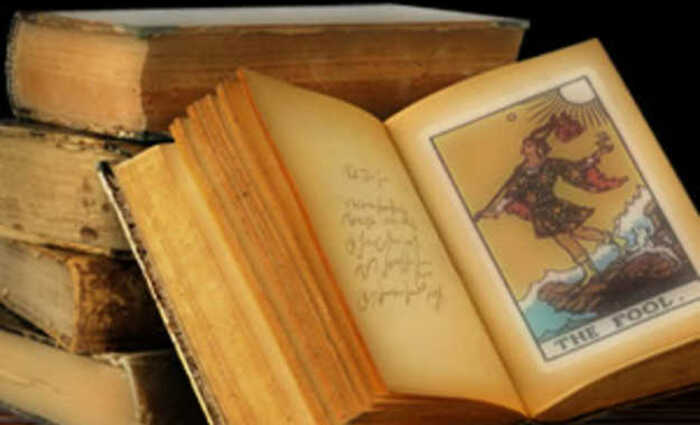
Universal Belief in Magic
Discover how far and wide magic stretches
1. Universal belief in magic
There are a number of things that we know about magic in 15th century Italy with a fair degree of historical certainty. We know, for example, that there was a universal belief in the efficacy of magic. So if one were to ask whether the Tarot designers and early card-players believed in magic, the answer is yes.
There was a universal belief in magic that extended from ancient times through the medieval period and into the Renaissance (Thorndike 1904). The early stages of the long tradition of magic are documented in Coptic ritual texts (Meyer and Smith 1994) and Egyptian magical papyri (Griffith and Thompson 1904, Borghouts 1978). Numerous ecclesiastical documents complain that magic is to be found everywhere (Flint 1991). The noted preacher, Bernardino of Sienna (1380-1444), states that he found seers, sorcerers, diviners and witches in every Italian town he visited (Mormando 1999).
Many forms of magic, particularly those involving the assistance of demons, were forbidden and the medieval legal systems imposed penalties. Interestingly, the discussions of magic in these legal documents are rather terse. Flint (1991) points out that magic was so well known that it didn't take many words to elucidate. Religious sources continue to rail against magical practices throughout the medieval period but the fact that they continued to rail means that magic continued to be practiced.
Belief in Magic was not restricted to the commoners. Pope John XXII (1316-1334) had a knife with a handle of serpent's horn that could detect poisons and he used it at his table for years (Thorndike 1934). Nobles and clergy shared a belief in the occult virtues of objects, such as the healing properties of gems. Carved stones with specific astrological associations were often used in medicine (Evans 1922). The intellectual interest in magic largely began in the 12th century with the translation of Arabic manuscripts on medicine and astrology (Jolly 2002). From the 12th to the 15th century, white magic (i.e., performed without the aid of demons) was largely viewed simply as knowledge of the natural world.
The efficacy of magic was accepted by the greatest intellectuals of the middle ages. Even St. Thomas Aquinas affirmed the reality of magic (Thorndike 1923). In 1441, Franciscus Florentinus was dean of the college of theologians and dean at Florence. He believed in the occult virtues of gems and natural objects and even defended the idea that incantations useful for affecting a cure were licit (Thorndike 1934). Raphael of Pornasio, the inquisitor at Genoa (1430-1450), maintained that there is no necessary conflict between theology and the magical use of natural objects (Thorndike 1934).
An important source indicating the universal belief in magic is hagiography, the documentation of the lives and miracles of the saints. To be accepted by the Church as a true saint, it was necessary to document miracles. Therefore, a literature developed describing the "blessed" magic performed by the saints and there was a lively economic market in saint's relics (Brooke 1984). Since so many saints were canonized during the Middle Ages, the highest levels of the Roman Curia obviously believed in miracles, i.e., magic performed through the intercession of the supernatural. Indeed, discriminating between charlatans and true saints was a constant challenge for the Church (Schutte 2001).
Another source of information on the universal belief in magic is the Penitential literature (McNeill and Gamer 1938). Starting in ninth century, manuals of instruction for parish priests, called Penitentials, were widely circulated. Their purpose was to help the priest instruct their parishioners and establish appropriate penances to be imposed when penitents confessed their sins. These manuals make it clear that the priest should ask questions about magic and should expect to hear evidence of magic continuing to be practiced by the people.
Interestingly, the Penitentials deal with a folk magic that is far removed from the astrology and alchemy that was discussed at length by contemporary intellectuals and carefully preserved in the literature. Folk magic dealt with subjects like sex magic (Brooke and Brooke 1984), fertility rites, healing, and divination. This folk magic was condemned as superstition or, if it was effective, was condemned as the work of demons. But many of the spells and rituals sound strangely like the more "learned" magic and so the two undoubtedly became broadly mixed over the ages.
Perhaps the clearest demonstration of the universal belief in magic is the strange abhoration of the witch hunts during the century following the appearance of the Tarot (Barstow 1994, Russell 1980). The fact that commoners, judges, and churchmen all were willing to punish witches indicates that they had a firm belief both in the existence of magic and its efficacy.
While the belief in magic was universal, there were some clear distinctions between learned magic and the beliefs of the piazza. Most writers believed that magic was largely illusionary. In the third quarter of the 14th century, Nicholas Oresme pointed out that most magic was sleight of hand and most astrological forecasts could be more simply explained by natural phenomena (Thorndike 1934). While he believed in magic, he argued that most who claimed to be magicians were charlatans or ignorant of the self-deceptions resulting from fasting, imbibing potions, and staring into mirrors.
Thorndike (1934) discusses a number of German, Italian and French treatises that detail folk magic. These treatises further demonstrate the universality of belief in magic and provide a record of what was believed by the early Tarot card-players. The works contain no confirmation of the oral transmission of ancient wisdom and simply document superstitions that had become part of the popular culture of uneducated Christians:
whichever of a bridal pair rose first from kneeling would be the dominant partner; an owl perching on the ridgepole of house meant someone would die; it was bad luck to meet a pregnant woman first thing in morning; if one's head cast no shadow at the feast of the Epiphany, one would die within a year; corpses must be carefully enshrouded and buried to prevent the ghost from returning; perfectly round eggs were only laid by roosters and would hatch as serpents; a cricket in the house was good luck; to insure the success of an undertaking, one should place an eyelash in one's shoe. There seems little in these widely held superstitions to support the concept that a secret pagan magical tradition was handed down by oral communication to initiates and resulted in a divination system in the Tarot.



